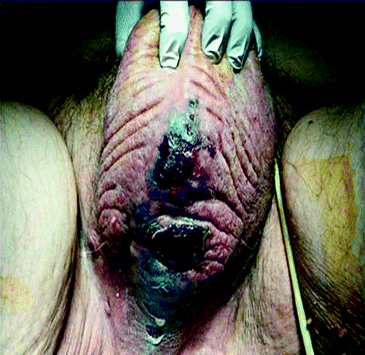Fig. 7.1
CT scan showing gas gangrene in the scrotum. This is consistent with Fournier’s gangrene. © Dale Dangleben, MD
Complications
The most feared complication is death with failure to recognize the condition or failure to adequately treat with appropriate resuscitation, surgery, and systemic broad-spectrum antibiotics. Other complications include multiple organ failures, soft tissue defects, impotence, emotional overlay, decreased quality of life, and consequences of surgery to surrounding anatomy (sphincter dysfunction, orchidectomy, and penile excision).
Management
The mainstay of treatment of FG is that it is a rapidly progressive disease with a high mortality. Early diagnosis, broad-spectrum antibiotics to cover Gram-positive, Gram-negative, and anaerobic organisms, with antifungal therapy where indicated, coupled with surgical debridement and control of the necrotizing infection are mandatory in treating FG. Where the disease has progressed to become systemic such as in severe sepsis, surgery should be preceded by resuscitation and hemodynamic support. The disease advances rapidly with the rate of progression reported as 1–2 cm per hour, and therefore, surgery should not be otherwise delayed.
Operative management includes debridement and drainage of all necrotic skin and subcutaneous tissue. The extent of resection should be limited to the point where the necrotic skin and necrotic subcutaneous fat can be easily elevated from underlying fascia and tissue. Patients should return to the OR frequently for reevaluation and further debridement as indicated. Between surgeries, the wound can be covered with Dakin’s solution soaked gauze to help topical control of infection. The perineal skin and organs are comprised of different blood supplies; the scrotal blood supply is from the pudendal branch of the femoral artery and that of the testicles and spermatic cords are from the testicular branch of the aorta. Therefore, the testicles should not be removed unless non-viability develops on the affected side (reported in 21% of patients). Only affected penile skin should be excised. Tissue cultures should be obtained at the time of the first operative debridement from which to focus antibiotic coverage (Figs. 7.2 and 7.3).










